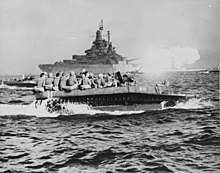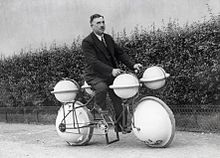Amphibious vehicle
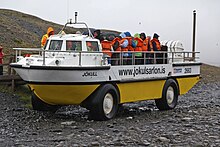

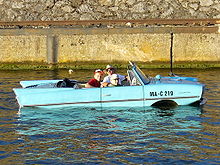

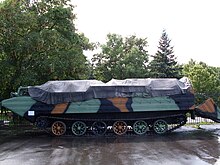

An amphibious vehicle is a vehicle that can travel both on land and on the surface of the water. The amphibious vehicle is named after the amphibians , animals that can live both on land and in water. In addition to motor vehicles with additional water propulsion, this also includes, in a broader sense, air cushion vehicles and amphibious aircraft .
history
First attempts at swimming
In 1588, the Italian Agostino Ramelli designed a chariot that was to be pulled on land by horses and moved in the water with two paddle wheels by muscle power.
In 1804, the American Oliver Evans developed the Orukter Amphibolos [sic], a steam-powered vehicle with four wheels and a paddle wheel at the rear. By adjusting pulleys, it was possible to switch to the respective drive. The vehicle was designed as a port dredger; after the ditch, the hull was separated from the chassis so that it could no longer return to land on its own.
The first known motorized amphibious vehicle was built in Denmark in 1899 under the name Magrelen Amphibium. Numerous other attempts followed to teach the relatively new automobiles to swim, most of which until the mid-1920s consisted of mounting chassis on boats. On April 19, 1909, Jean Rech from Mehlem was granted patent no. 208869 for a vehicle that could be used on water and on land.
Second World War
A significant boost in the development of buoyant vehicles was the requirement of the military in World War II to enable the amphibious landings of large units.
In Germany , the VW-128 was initially built for this purpose, a floatable version of the VW Kübelwagens , the spread of which, however, was limited due to poor driving characteristics on land and water.
Only the successor model, the Volkswagen Type 166 floating car , was built in larger numbers. Erwin Komenda , Porsche's first body designer, designed the model. He had his ideas for the swimming car patented by the German Patent Office . If you look at the mechanics, it was a converted KdF car (later known as a VW Beetle ). The floating car was manufactured at the Volkswagen factory in Wolfsburg . The newly founded city was then called the city of the KdF car near Fallersleben .
Regardless of this, the Allies were not inactive either and at around the same time created the Ford GPA , a buoyant jeep, and the DUKW , a small truck . Floatable variants of the Sherman tank , so-called DD tanks , and specially designed Landing Vehicle Tracked also took part in the landing in Normandy . These LVTs, with their numerous versions, formed the backbone of the Allied offensive in the Pacific War .
post war period
Military and civil protection
After the Second World War, several attempts were made to equip the military and civil protection with amphibious vehicles.
So should z. B. the Europa Jeep and the second generation of tactical trucks can float. In the armies of the Warsaw Pact , amphibious vehicles were to be found quite often, while in Western Europe one turned to wading facilities for passing through water hazards on the ground.
An example of a purely civil amphibious truck is the EWK Bison , which was intended for use in disaster control. In addition to the prototype, variants for fire extinguishing and recovery purposes were also to be built.
Civil
But also a number of civil attempts have been made to produce amphibious vehicles, e.g. B. Amphicar 770 and Amphi-Ranger ; Most of the floating vehicles, however, are built as custom conversions. Cuban refugees who tried to escape to the United States in converted American classic cars were particularly creative . Allegedly, however, they were always picked up by the coast guard and sent back, their vehicles were sunk.
In London, Seattle and Boston, converted DUKW are used for city tours including river trips.
Salzburg
On September 9, 2016, an amphibious bus from the entrepreneur Erich Berer had its maiden voyage in the Salzach in the city of Salzburg . The two-axle vehicle offers space for 26 passengers in the cabin behind a 2-man crew, has a floating body that protrudes slightly in the shape of a segment of a circle and two propellers. He had already received the nature conservation permit in October 2013, and then the permit under the state's water law and the shipping concession. The vehicle is a one-off production that was built in Linz , Salzburg and Traunstein, Bavaria , and the development of which took four years. Three engines provide a total of 630 hp in addition to a truck traction motor, the vehicle was fitted with two Volvo Penta marine diesel engines - each acting on a screw. Thanks to its lightweight construction, the bus for water and road weighs 7.7 t, is 9.50 m long and air-conditioned.
construction
There are some basic differences with regard to the structure of an amphibious vehicle:
Swimming sausages
Swimming sausages are the easiest way to make a vehicle buoyant. For this purpose, floating bodies are usually attached to the side of the vehicle , which are either inflatable or solid. Inflatable swimming sausages require more time to become buoyant, but are easier to transport than the usually quite bulky solid structures. They can be used for all vehicles; the modifications to the vehicle are limited.
Buoyant hull
If the hull of a vehicle is to become buoyant, extensive changes to the bodywork are necessary in order to seal it off against water from the side of the ship. The problem is always the power transmission from the motor, which is usually located inside the cover, to the driven axles and the implementation of the steering column . For this purpose, either the complete drive unit from the gearbox is left outside the body, or only the wheels with suspensions are mounted outside the float and the axles are sealed. The seals used here are exposed to heavy wear and tear due to the constant movement during compression and rebound. In order to circumvent this problem, the Spios company decided not to have a suspension system for its vehicle, which leads to approval problems in Germany and, under certain circumstances, can result in cracks in the outer shell in the area of the axle bushings.
Some amphibious vehicles use a combination of the above options; so were z. B. retrofitted the prototype of the Terrawind boom with inflatable floats to increase stability in the water.
Propulsion in the water
Various construction principles are used for propulsion in water:
- Water jet drive installed in the vehicle body , which is driven by the traction motor (e.g. Watercar)
- Propeller mounted on transfer case / cardan shaft (e.g. Amphi-Ranger )
- hydraulically driven propeller (e.g. Fuchs )
- Drive via the wheels (e.g. LuAZ-967 ) or chains (e.g. Bv 206 HÄGGLUNDS )
- Propulsion by propeller or jet engine .
- Snailochod , drive via elongated, cylindrical screws (e.g. SIL-2906 )
Examples
Military |
||
|---|---|---|
Civil |
||
Active manufacturers of civil amphibious vehicles
Construction kits and conversion kits
- Dutton Marine is a conversion based on the Suzuki Samurai or Suzuki Jimny .
- Watercar manufactures a sporty convertible with a 300 hp engine.
Finished vehicles
- Sealegs is a boat with retractable wheels.
- In China, Beijing builds Isuzu-based amphibious vehicles that do not meet western emissions regulations and are therefore not approved here.
- Spios is a German manufacturer. Due to the unsprung construction, it is only approved as an agricultural vehicle up to 25 km / h in Germany.
- Amphicoach manufactures the floating bus AmphiCoach GTS-1 .
- In addition to luxury motorhomes, CAMI LLC also produces coaches, roadsters and off-road vehicles.
- Gibbs Technologies is the British manufacturer of the Gibbs Aquada (floatable roadster), the Gibbs Humdinga (floatable off-road vehicle) and the Gibbs Quadski (mixture of quad and jet ski).
- The Russian company Scherp produces the off-road amphibious vehicle of the same name .
- The Tupolev A-3 is an all-metal amphibious vehicle.
event
A swimming car meeting has been organized in the Salzkammergut since the 1960s . It was a guest at the Attersee (..., 2018), Mondsee (..., 2019), Traunsee (2016, 2017) and Wolfgangsee . A typical date is Pentecost (June 8-10, 2019).
In 2019, the organizer, the Linz dentist Michael Stelzl, estimates that there are around 50 to 60 swim cars in Austria, of which around 25 can still swim. In 2018 about 40 vehicles swam in the Attersee.
See also
swell
- ↑ Beverly Rae Kimes, Henry Austin Clark Jr .: Standard catalog of American Cars. 1805-1942. Digital edition . 3. Edition. Krause Publications, Iola 2013, ISBN 978-1-4402-3778-2 , pp. 552 (English).
- ^ Beverly Rae Kimes: Pioneers, Engineers, and Scoundrels: The Dawn of the Automobile in America . Ed. SAE ( Society of Automotive Engineers ). Permissions, Warrendale PA, 2005, ISBN 0-7680-1431-X , pp. 3-5.
- ^ Hasso Erb: floating car: cars and trucks; Development, technology, types. Motorbuch Verlag , Stuttgart 1988, ISBN 3-613-01165-4
- ^ London Ducktours ( Memento of August 8, 2008 in the Internet Archive )
- ↑ Seattle DUCKTOURS
- ↑ Boston DUCKTOURS
- ↑ New amphibious bus for tourists orf.at, August 31, 2016, accessed September 9, 2016. - Bus presentation in Salzburg.
- ↑ dmund Brandner: Swimming car meeting: Cars go swimming in Mondsee at Whitsun June 6, 2019, accessed June 8, 2019.
Web links
- Amphibious vehicles. When the cars went swimming. Mirror online

